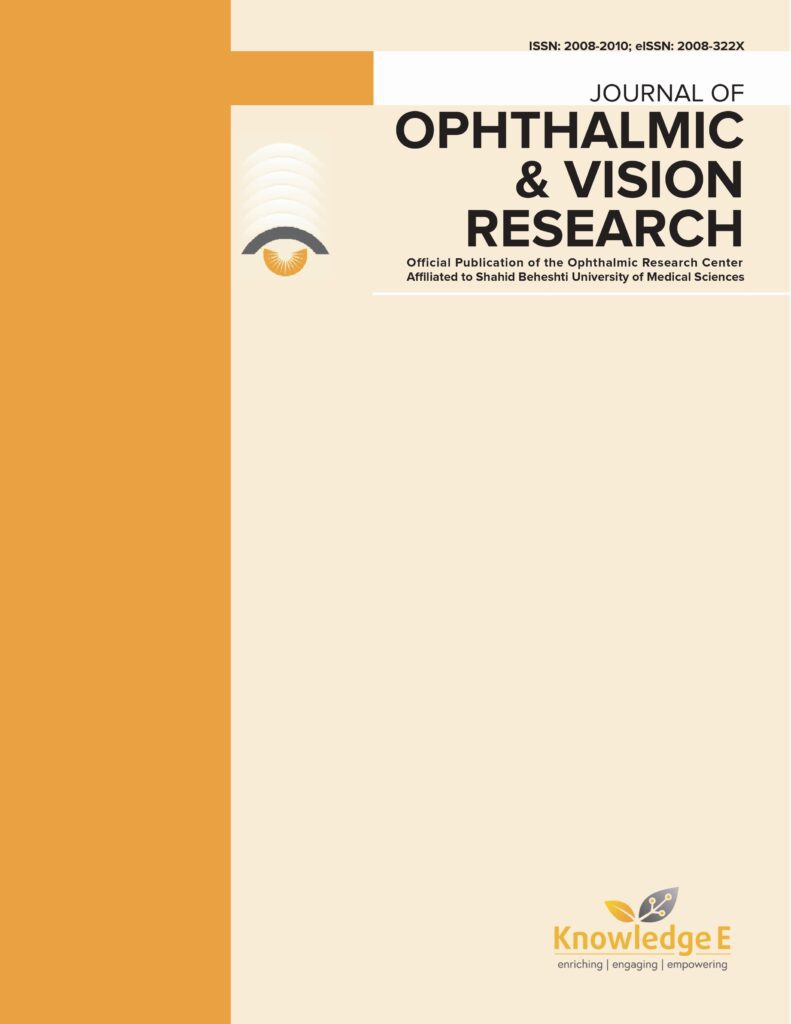
Journal of Ophthalmic and Vision Research
ISSN: 2008-322X
The latest research in clinical ophthalmology and vision science
Long-term Results of Topical Insulin Treatment for Persistent Corneal Epithelial Defects
Published date: Dec 31 2024
Journal Title: Journal of Ophthalmic and Vision Research
Issue title: Oct–Dec 2024, Volume 19, Issue 4
Pages: 397 - 405
Authors:
Abstract:
Purpose: To evaluate the effects of topical insulin in patients with persistent corneal epithelial defects that are refractory to the standard treatment.
Methods: A retrospective, hospital-based, clinical study was performed on 17 eyes of 16 patients with different types of refractory persistent epithelial defects who were treated with topical insulin. The treatment was continued until the defect either was resolved or persisted after three months. Patients’ demographic information, etiology, comorbidities, and clinical data were reviewed. The rate of epithelial healing was considered as the primary outcome measure.
Results: Neurotrophic keratitis was the most common cause of persistent epithelial defects (58.8%), and within this category, herpetic eye disease was the main comorbidity (44.4%). The mean follow-up time was 17.91 months. Eleven out of fifteen eyes (77.3%) had complete improvement and only one patient did not respond to the treatment. The mean time of reepithelization for the eyes with full recovery was 31.27 days (ranging from 6 to 61 days). The best-corrected visual acuity improved significantly after treatment (P < 0.005), and there were no reports of complications or side effects during the study period.
Conclusion: Our results suggest that topical insulin, due to its good safety profile, availability, and affordability, could be a good therapeutic alternative for persistent epithelial defects.
Keywords: Cornea, Corneal ulcer, Herpetic Keratitis, Insulin, Keratitis
References:
1. Eghrari AO, Riazuddin SA, Gottsch JD. Overview of the cornea: Structure, function, and development. Prog Mol Biol Transl Sci 2015;134:7–23.
2. Vaidyanathan U, Hopping GC, Liu HY, Somani AN, Ronquillo YC, Hoopes PC, et al. Persistent corneal epithelial defects: A review article. Med Hypothesis Discov Innov Ophthalmol 2019;8:163–176.
3. Katzman LR, Jeng BH. Management strategies for persistent epithelial defects of the cornea. Saudi J Ophthalmol 2014;28:168–172.
4. Wilson SE, Medeiros CS, Santhiago MR. Pathophysiology of corneal scarring in persistent epithelial defects after PRK and other corneal injuries. J Refract Surg 2018;34:59– 64.
5. NaPier E, Camacho M, McDevitt TF, Sweeney AR. Neurotrophic keratopathy: Current challenges and future prospects. Ann Med 2022;54:666–673.
6. Shtein RM, Shen JF, Kuo AN, Hammersmith KM, Li JY, Weikert MP. Autologous serum-based eye drops for treatment of ocular surface disease: A report by the American Academy of Ophthalmology. Ophthalmology 2020;127:128–133.
7. Diaz-Valle D, Burgos-Blasco B, Gegundez-Fernandez JA, Garcia-Caride S, Puebla-Garcia V, Peña-Urbina P, et al. Topical insulin for refractory persistent corneal epithelial defects. Eur J Ophthalmol 2021;31:2280–2286.
8. Pflugfelder SC, Massaro-Giordano M, Perez VL, Hamrah P, Deng SX, Espandar L, et al. Topical recombinant human nerve growth factor (cenegermin) for neurotrophic keratopathy: A multicenter randomized vehicle-controlled pivotal trial. Ophthalmology 2020;127:14–26.
9. Moon HS, Li L, Yoon HJ, Ji YS, Yoon KC. Effect of epidermal growth factor ointment on persistent epithelial defects of the cornea. BMC Ophthalmol 2020;20:147.
10. Titone R, Zhu M, Robertson DM. Insulin mediates de novo nuclear accumulation of the IGF-1/insulin hybrid receptor in corneal epithelial cells. Sci Rep 2018;8(1):1–13.
11. Tong CM, Iovieno A, Yeung SN. Topical insulin for neurotrophic ulcers. Can J Ophthalmol 2020;55:170–172.
12. Galvis V, Niño CA, Tello A, Grice JM, Gómez MA. Insulina tópica en queratopatía neurotrófica tras resección de neurinoma del acústico. Arch Soc Esp Oftalmol (Engl Ed) 2019;94:100–104.
13. Wang AL, Weinlander E, Metcalf BM, Barney NP, Gamm DM, Nehls SM, et al. The use of topical insulin to treat refractory neurotrophic corneal ulcers. Cornea 2017;36:1426–1428.
14. Castro Mora MP, Palacio Varona J, Perez Riaño B, Laverde Cubides C, Rey-Rodriguez DV. Effectiveness of topical insulin for the treatment of surface corneal pathologies. Arch Soc Esp Oftalmol (Engl Ed) 2023;98:220–232.
15. Soares RJ, Arêde C, Sousa Neves F, da Silva Fernandes J, Cunha Ferreira C, Sequeira J. Topical insulin-utility and results in refractory neurotrophic keratopathy in stages 2 and 3. Cornea 2022;41:990–994.
16. Anitua E, de la Fuente M, Sánchez-Ávila RM, de la Sen- Corcuera B, Merayo-Lloves J, Muruzábal F. Beneficial effects of plasma rich in growth factors (PRGF) versus autologous serum and topical insulin in ocular surface cells. Curr Eye Res 2023;48:456–464.
17. Aynsley TR. The use of insulin in the treatment of corneal ulcers. Br J Ophthalmol 1945;29:361–363.
18. Wang AL, Weinlander E, Metcalf BM, Barney NP, Gamm DM, Nehls SM, et al. Use of topical insulin to treat refractory neurotrophic corneal ulcers. Cornea 2017;36:1426–1428.
19. Castro Mora MP, Palacio Varona J, Perez Riaño B, Laverde Cubides C, Rey-Rodriguez DV. Effectiveness of topical insulin for the treatment of surface corneal pathologies. Arch Soc Esp Oftalmol (Engl Ed) 2023;98:220–232.
20. Shtein RM, Shen JF, Kuo AN, Hammersmith KM, Li JY, Weikert MP. Autologous serum-based eye drops for treatment of ocular surface disease: A report by the american academy of ophthalmology. Ophthalmology 2020;127:128–133.
21. Diaz-Valle D, Burgos-Blasco B, Rego-Lorca D, Puebla- Garcia V, Perez-Garcia P, Benitez-Del-Castillo JM, et al. Comparison of the efficacy of topical insulin with autologous serum eye drops in persistent epithelial defects of the cornea. Acta Ophthalmol 2022;100:e912– 9.
22. Bonini S, Lambiase A, Rama P, Sinigaglia F, Allegretti M, Chao W, et al.; REPARO Study Group. Phase II randomized, double-masked, vehicle-controlled trial of recombinant human nerve growth factor for neurotrophic keratitis. Ophthalmology 2018;125:1332–1343.
23. Pflugfelder SC, Massaro-Giordano M, Perez VL, Hamrah P, Deng SX, Espandar L, et al. Topical recombinant human nerve growth factor (cenegermin) for neurotrophic keratopathy: A multicenter randomized vehicle-controlled pivotal trial. Ophthalmology 2020;127:14–26.
